What'sNEW Oct - Dec 2023
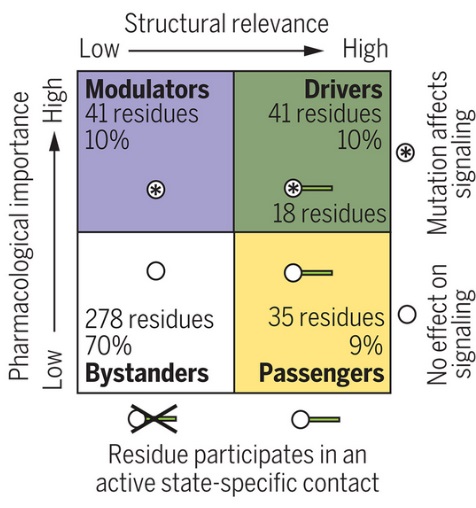 Let's understand how every amino acid contributes to the functioning of a receptor by mutating them, one amino acid at a time. — M. Madan Babu, Biological Data Science, St Jude Hospital, coauthor.
Let's understand how every amino acid contributes to the functioning of a receptor by mutating them, one amino acid at a time. — M. Madan Babu, Biological Data Science, St Jude Hospital, coauthor.
An international team explored the adrenaline receptor protein, a member of the G protein-coupled receptor (GPCR) family, to eventually learn where drugs should be targetted. Each of the 412 amino acids of this one was altered, and 82 of the substitutions had measurable effect. For a mild surprise, most of these were not in the enzymatic binding sites. This revealing study gives drug designers a new resource to work with. Very commendable.
 "Molecular determinants of ligand efficacy and potency in GPCR signaling," by Franziska M. Heydenreich et al., Science, 22 Dec 2023. "Molecular determinants of ligand efficacy and potency in GPCR signaling," by Franziska M. Heydenreich et al., Science, 22 Dec 2023.
 "GPCR structure: Research reveals molecular origins of function for a key drug target," St. Jude Children's Research Hospital via Newswise, 21 Dec 2023. "GPCR structure: Research reveals molecular origins of function for a key drug target," St. Jude Children's Research Hospital via Newswise, 21 Dec 2023.
Does the research also shed light on how the GCPRs evolved? One might infer from it that 70 to 80 percent of these amino acids, "Bystanders" or "Passengers" in the table, could safely be anything at all, and only the others are constrained. But here, each position was replaced with alanine, except native alanines were replaced with glycine. If other amino acids had been inserted, other positions may have shown measurable effect, so the inference is not fully warranted.
 "The Relationship Between Relative Solvent Accessibility and Evolutionary Rate in Protein Evolution," by Duncan C. Ramsey et al., doi:10.1534/genetics.111.128025, Genetics, 2011. In real proteins, it may well be that at one site 3 amino acids are preferred and 17 unpreferred, while at a different site 5 are preferred and 15 unpreferred. ...At any given site, only a small number of amino acids are actually permissible. "The Relationship Between Relative Solvent Accessibility and Evolutionary Rate in Protein Evolution," by Duncan C. Ramsey et al., doi:10.1534/genetics.111.128025, Genetics, 2011. In real proteins, it may well be that at one site 3 amino acids are preferred and 17 unpreferred, while at a different site 5 are preferred and 15 unpreferred. ...At any given site, only a small number of amino acids are actually permissible.
 Robust Software Management has many examples of complex genetic programming with no hint of an explanation from the mainstream theory of evolution. This disconnect is growing steadily. Robust Software Management has many examples of complex genetic programming with no hint of an explanation from the mainstream theory of evolution. This disconnect is growing steadily.
Samples of asteroid Bennu contain hydrated clay minerals, organics and more. And the cannister won't open.
 "...first look at asteroid dust brought to Earth offers surprises," by Alexandra Witze, Nature, 12 Dec 2023. "...first look at asteroid dust brought to Earth offers surprises," by Alexandra Witze, Nature, 12 Dec 2023.
 Comet Rendezvous has history and updates since 1997. Comet Rendezvous has history and updates since 1997.
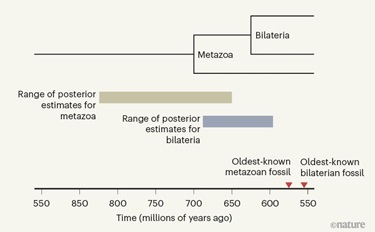 Genes always look too old, by molecular clock dating, than they should be according to the fossil record. The fossil record is now extensive and considered accurate — red triangles in the graph indicate two reliable dates. But the clock data, tan and blue bars that should match the left and right triangles, respectively, are imprecise, and the whole range looks wrong. A recent analysis suggests that faulty statistical methods may lead to the dilemma.
Genes always look too old, by molecular clock dating, than they should be according to the fossil record. The fossil record is now extensive and considered accurate — red triangles in the graph indicate two reliable dates. But the clock data, tan and blue bars that should match the left and right triangles, respectively, are imprecise, and the whole range looks wrong. A recent analysis suggests that faulty statistical methods may lead to the dilemma.
 "...A Critical Examination of Relaxed Molecular Clock Age Estimates of the Bilaterian Animals and Placental Mammals," by Graham E Budd and Richard P Mann, Systematic Biology, 11 Sep 2023; and commentary: "...A Critical Examination of Relaxed Molecular Clock Age Estimates of the Bilaterian Animals and Placental Mammals," by Graham E Budd and Richard P Mann, Systematic Biology, 11 Sep 2023; and commentary:
 "Genes are often uninformative for dating species' origins," by Matt Pennell, Nature, 22 Nov 2023.
Many other studies find similar discrepancies. It's time to admit a possibilty: The genes may actually be old. "Genes are often uninformative for dating species' origins," by Matt Pennell, Nature, 22 Nov 2023.
Many other studies find similar discrepancies. It's time to admit a possibilty: The genes may actually be old.
To see what is in front of one's nose needs a constant struggle — George Orwell, 1946.
 Metazoan Genes Older Than Metazoa? and Metazoan Genes Older Than Metazoa? and
 Genes Older Than Earth? have more examples. Genes Older Than Earth? have more examples.
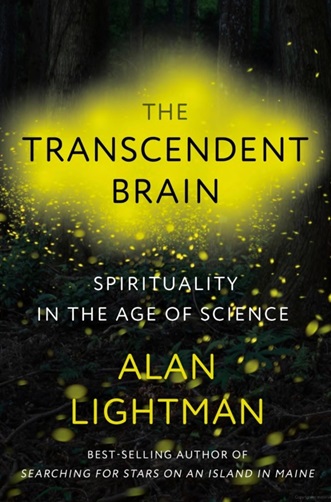 Dear Alan – I have now spent two hours with The Transcendent Brain. Your knowledge of the history of science and of religious philosophy invites me to learn more in several directions — I underlined a lot of names. And, like you, I have felt challenged to explain how I can have a rich and complete spiritual life without believing in a supernatural God. It was easy for me to relate to your experiences and observations. Your encounter with the two juvenile ospreys was especially dramatic. We, too, are animals, of course, and we love our children with an animal ferocity that needs no religious imperative.
Dear Alan – I have now spent two hours with The Transcendent Brain. Your knowledge of the history of science and of religious philosophy invites me to learn more in several directions — I underlined a lot of names. And, like you, I have felt challenged to explain how I can have a rich and complete spiritual life without believing in a supernatural God. It was easy for me to relate to your experiences and observations. Your encounter with the two juvenile ospreys was especially dramatic. We, too, are animals, of course, and we love our children with an animal ferocity that needs no religious imperative.
I'm glad that you mention emergent phenomena like sync-blinking fireflies. My favorite examples come from Conway's Game of Life, and from the algorithms for fractals. Both produce complex images that could not be anticipated by knowing the short programs that produce them. Given the complexity of our human genetic programming, why couldn't consciousness emerge from it? I understand you to be saying the same thing.
As you know, the complexity of life leads me to conclude that life cannot originate, nor advance as it has, de novo. That would mean that, without supernatural intervention, life must come from eternity.
That's a worldview with consolations that you would understand. In any case, thanks for an edifying and thought-provoking book.
 The Transcendent Brain: Spirituality in the Age of Science, by Alan Lightman, Pantheon, 14 Mar 2023. The Transcendent Brain: Spirituality in the Age of Science, by Alan Lightman, Pantheon, 14 Mar 2023.
| 09 Dec 2023 |
What'sNEW about HGT


|
More than 12 million years ago, it is likely that a single bacterium transferred genetic material into a single mussel endowing its descendants with the ability to make these fibers — McGill Professor Matthew Harrington.
 "Invasive mussels fashion silk-like byssus via mechanical processing of massive horizontally acquired coiled coils," by Miriam Simmons et al., PNAS, 20 Nov 2023. "Invasive mussels fashion silk-like byssus via mechanical processing of massive horizontally acquired coiled coils," by Miriam Simmons et al., PNAS, 20 Nov 2023.
 "Zebra Mussel Fibers Reveal Invasive Species, Sustainable Materials Solutions," Mirage, 09 Dec Dec 2023. "Zebra Mussel Fibers Reveal Invasive Species, Sustainable Materials Solutions," Mirage, 09 Dec Dec 2023.
 Thanks, Google Alerts.
HGT is a frequent and crucial source of new genetic programming for eukaryotic life. Some are slow to recognize it. That's why a "single" event is proposed. But the examples are countless. Thanks, Google Alerts.
HGT is a frequent and crucial source of new genetic programming for eukaryotic life. Some are slow to recognize it. That's why a "single" event is proposed. But the examples are countless.
 Viruses... has many examples of HGT across all of life. Viruses... has many examples of HGT across all of life.
| 06 Dec 2023 |
What'sNEW about HGT


|
The shock from an electric eel can facilitate Horizontal Gene Transfer. Electric current opens pores in the cell membrane through which eDNA may enter. "Electroporation" is a known laboratory technique, but the possibility that eels may cause it in nature is new.
 "Electric organ discharge from electric eel facilitates DNA transformation into teleost larvae in laboratory conditions," by Shintaro Sakaki et al., Peer J, 04 Dec 2023. "Electric organ discharge from electric eel facilitates DNA transformation into teleost larvae in laboratory conditions," by Shintaro Sakaki et al., Peer J, 04 Dec 2023.
 "...Electricity from electric eels may transfer genetic material to nearby animals," Nagoya University via Newswise +PhysOrg, and see Newsweek, 05-06 Dec 2023. "...Electricity from electric eels may transfer genetic material to nearby animals," Nagoya University via Newswise +PhysOrg, and see Newsweek, 05-06 Dec 2023.
 Viruses... has many examples of HGT across all of life. Viruses... has many examples of HGT across all of life.
There are plenty of people who know a great deal about evolution, but because of conflicts with their worldview, they reject it outright.
— Amanda Townley, new Executive Director, National Center for Science Education
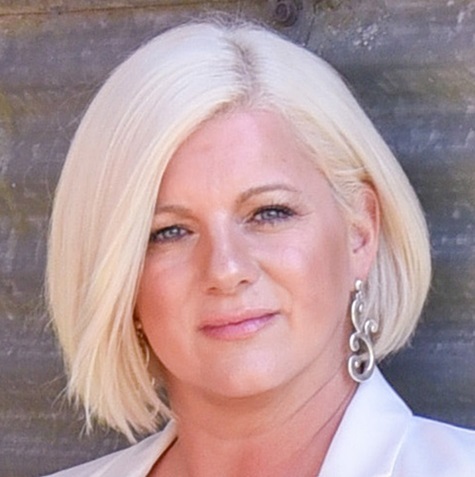
 "Brought up in a creationist home, a scientist fights for evolution," Science, 29 Nov 2023.
I'm glad NCSE acknowledges that people who "know a great deal about evolution" may still reject the theory as it is taught in school. They do so because the explanatory mechanism, neo-darwinism, including its modern variants, is implausible and unproven. The actual evidence points elsewhere. NCSE hinders science by ignoring the evidence and demeaning the skeptics, as if they all have unscientific worldviews. "Brought up in a creationist home, a scientist fights for evolution," Science, 29 Nov 2023.
I'm glad NCSE acknowledges that people who "know a great deal about evolution" may still reject the theory as it is taught in school. They do so because the explanatory mechanism, neo-darwinism, including its modern variants, is implausible and unproven. The actual evidence points elsewhere. NCSE hinders science by ignoring the evidence and demeaning the skeptics, as if they all have unscientific worldviews.
 Evolution vs Creationism has discussion and updates. Evolution vs Creationism has discussion and updates.
 05 Jul 2009: from the previous Executive Director of NCSE 05 Jul 2009: from the previous Executive Director of NCSE
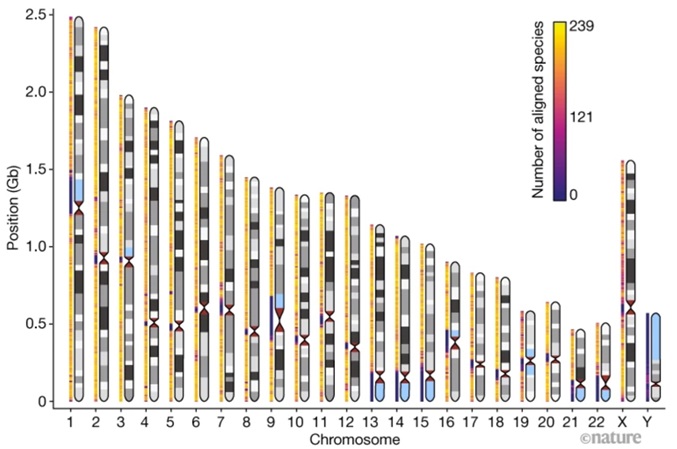 We discover hundreds of thousands of regulatory elements that emerged very recently in evolution and are specific to primates and humans, and are not present in other mammals.
We discover hundreds of thousands of regulatory elements that emerged very recently in evolution and are specific to primates and humans, and are not present in other mammals.
— Kyle Kai-How Farh, VP of artificial intelligence at Illumina and leading coauthor of a new study in Nature.
 "Identification of constrained sequence elements across 239 primate genomes," by L.F.K. Kuderna, J.C. Ulirsch, S. Rashid et al., doi:10.1038/s41586-023-06798-8, Nature, 29 Nov 2023. "Identification of constrained sequence elements across 239 primate genomes," by L.F.K. Kuderna, J.C. Ulirsch, S. Rashid et al., doi:10.1038/s41586-023-06798-8, Nature, 29 Nov 2023.
 "Whole-genome alignment with primates reveals DNA elements conserved in humans" (summary), Nature, 29 Nov 2023. "Whole-genome alignment with primates reveals DNA elements conserved in humans" (summary), Nature, 29 Nov 2023.
 "Comparison of 239 Primate Genomes Reveals Conserved Regulatory Sequences," by Andrea Anderson, GenomeWeb, 29 Nov 2023.
As the burgeoning data from genome sequencing is submitted to
powerful computers, we are sure to encounter surprises. It will help to look with open eyes. Here, Dr. Fahr's summary suggests that this research supports cosmic ancestry's longstanding prediction for macroevolution leading to in humans: "...nearly identical versions... or nothing similar...." "Comparison of 239 Primate Genomes Reveals Conserved Regulatory Sequences," by Andrea Anderson, GenomeWeb, 29 Nov 2023.
As the burgeoning data from genome sequencing is submitted to
powerful computers, we are sure to encounter surprises. It will help to look with open eyes. Here, Dr. Fahr's summary suggests that this research supports cosmic ancestry's longstanding prediction for macroevolution leading to in humans: "...nearly identical versions... or nothing similar...."
 New genetic programs..., proposed in 2002, explains the prediction (using some outdated terms.) New genetic programs..., proposed in 2002, explains the prediction (using some outdated terms.)
| 23 Nov 2023 |
What'sNEW about HGT


|
...the potential of horizontal gene transfers in eukaryotes....
 "Horizontal acquisition of a DNA ligase improves DNA damage tolerance in eukaryotes," by E. Nicolas, P. Simion, M. Guérineau et al., Nature, 22 Nov 2023. "Horizontal acquisition of a DNA ligase improves DNA damage tolerance in eukaryotes," by E. Nicolas, P. Simion, M. Guérineau et al., Nature, 22 Nov 2023.
 Viruses... has many examples of HGT across all of life. Viruses... has many examples of HGT across all of life.
| 17 Nov 2023 |
What'sNEW about HGT


|
Extracellular vesicles play a much greater role in horizontal gene transfer in the ocean than previously assumed.
 "Extracellular vesicles are the main contributor to the non-viral protected extracellular sequence space," by D. Lücking, C. Mercier, T. Alarcón-Schumacher et al., ISME Commun., 17 Oct 2023. "Extracellular vesicles are the main contributor to the non-viral protected extracellular sequence space," by D. Lücking, C. Mercier, T. Alarcón-Schumacher et al., ISME Commun., 17 Oct 2023.
 "Much more than waste: Tiny vesicles exchange genetic information between cells in the sea," Max Planck Institute for Marine Microbiology (+ScienceDaily), 16 Nov 2023. "Much more than waste: Tiny vesicles exchange genetic information between cells in the sea," Max Planck Institute for Marine Microbiology (+ScienceDaily), 16 Nov 2023.
 10 Mar 2021: local hub for HGT among bacteria, with updated links. 10 Mar 2021: local hub for HGT among bacteria, with updated links.
 Viruses... mentions transformation, the acquisition of DNA from the environment. Viruses... mentions transformation, the acquisition of DNA from the environment.
Pseudo-Panspermia gets a fresh endorsement from Cambridge University.
 "Can comets deliver prebiotic molecules to rocky exoplanets?" by R.J. Anslow, A. Bonsor and P.B. Rimmer, Proc. R. Soc. A., 15 Nov 2023. "Can comets deliver prebiotic molecules to rocky exoplanets?" by R.J. Anslow, A. Bonsor and P.B. Rimmer, Proc. R. Soc. A., 15 Nov 2023.
 "'Bouncing' comets could deliver building blocks for life to exoplanets," University of Cambridge, 15 Nov 2023. "'Bouncing' comets could deliver building blocks for life to exoplanets," University of Cambridge, 15 Nov 2023.
 Thanks, PhysOrg.com and Google Alerts. Thanks, PhysOrg.com and Google Alerts.
 "Cometary Delivery of Organic Molecules to the Early Earth," by Christopher F. Chyba, Paul J. Thomas, Leigh Brookshaw and Carl Sagan, Science, 27 July 1990. "Cometary Delivery of Organic Molecules to the Early Earth," by Christopher F. Chyba, Paul J. Thomas, Leigh Brookshaw and Carl Sagan, Science, 27 July 1990.
 Comets: The Delivery System has an overview and updates since 1998. Comets: The Delivery System has an overview and updates since 1998.
 ...New Questions describes various types of panspermia. ...New Questions describes various types of panspermia.
There are about 181,000 annotated exons within the approximately 20,000 known, protein-coding human genes. But "the human genome contains over a million autonomous exons" (including the annotated, coding ones.) They were identified using the 3' and 5' splice sites which characterize them.
These findings reinforce speculation that much of the "dark matter" transcriptome may be a by-product, or even an expected component, of the regulation of known genes, as well as a source of novel genetic entities. If the extra exons contain potentially useful genetic programming, with no evidence of neo-darwinian trial-and-error, cosmic ancestry gains implicit support.
 The human genome contains over a million autonomous exons, by Nicholas Stepankiw, Ally W H Yang and Timothy R Hughes, Genome Res., published in advance, 09 Nov 2023. The human genome contains over a million autonomous exons, by Nicholas Stepankiw, Ally W H Yang and Timothy R Hughes, Genome Res., published in advance, 09 Nov 2023.
 Human Genome Search describes a discontinued research project with relevant discussion and updates. Human Genome Search describes a discontinued research project with relevant discussion and updates.
 Robust Software Management is even more impressive if it can handle this much complexity. Robust Software Management is even more impressive if it can handle this much complexity.
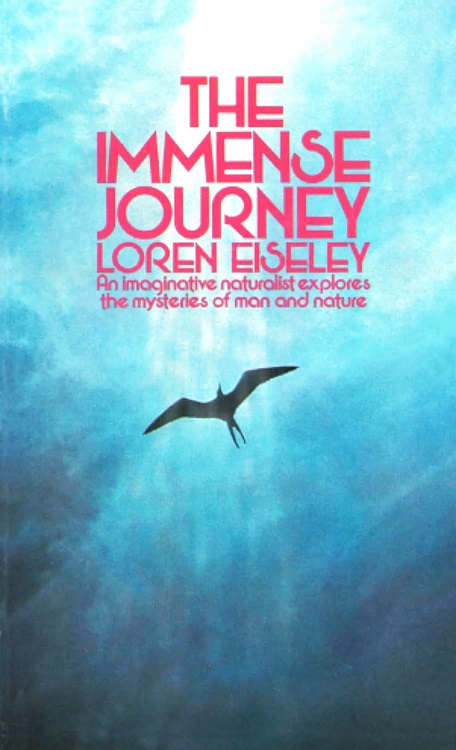
|
With the failure of these many efforts science was left in the somewhat embarrassing position of having to postulate theories of living organisms which it could not demonstrate. After having chided the theologian for his reliance on myth and miracle, science found itself in the unenviable position of having the create a mythology of its own: namely the assumption that what, after long effort, could not be proved to take place had, in truth, taken place in the primeval past.
|
Loren Eisley (1907-1977) was a respected anthropologist, ecologist and essayist. He drew deep satisfaction and wonder from the majesty of life, describing it in rich, resonant prose. When his collection of fourteen essays, The Immense Journey, was published in 1957, it became a surprise bestseller. The above quotation appears in the final essay, "The Secret of Life." Another one, "The Flow of the River," includes these words:
|
...more delicate, elusive , quicker than fins in water, is that mysterious principle known as "organization," which leaves all other mysteries concerned with life stale and insignificant by comparison. For that without organization life does not persist is obvious. Yet this organization itself is not strictly the product of life, nor of selection. Like some dark and passing shadow within matter, it cups out the eyes' small windows or spaces the notes of a meadowlark's song in the interior of a mottled egg. That principle—I am beginning to suspect—was there before the living in the deeps of water.
|
 The Immense Journey: An Imaginative Naturalist Explores the Mysteries of Man and Nature, by Loren Eisley, 1957. The Immense Journey: An Imaginative Naturalist Explores the Mysteries of Man and Nature, by Loren Eisley, 1957.
Dr. Richard Hoover, astrobiologist and former NASA astrophysicist, will give a lecture about his journey in science and discoveries along the way. This event is free and open to the public at the U.S. Space & Rocket Center's Discovery Theater, Huntsville AL, 2PM, Sunday, 12 Nov 2023.
 ...Microfossils in a Carbonaceous Meteorite includes a list of Hoover's collected articles. ...Microfossils in a Carbonaceous Meteorite includes a list of Hoover's collected articles.
Is it safe to bring samples of Mars to Earth? Some say no.
 "Searching for life on Mars isn't worth the risk to Earth," by Paul Marks, New Scientist, 01 Nov 2023. "Searching for life on Mars isn't worth the risk to Earth," by Paul Marks, New Scientist, 01 Nov 2023.
 07 Nov 2023: NASA vs ICAMSR from Barry DiGregorio. 07 Nov 2023: NASA vs ICAMSR from Barry DiGregorio.
 Life on Mars! has more. Life on Mars! has more.
| 06 Nov 2023 |
What'sNEW about HGT


|
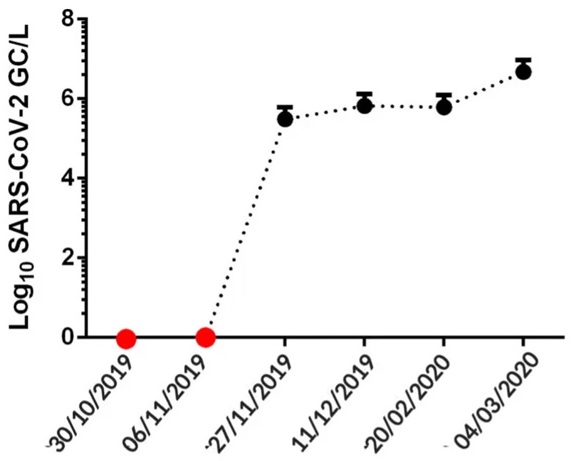 When and where did COVID-19 first infect people? A comprehensive review of this issue, looking at archived samples from around the world, indicates that human infections became widespread earlier and more rapidly than previously known. For example, in mid-November 2019, SARS-CoV-2 RNA suddenly spiked and remained high in the sewage of Florianópolis, Brazil (graph). Blood and tissue samples from France, Italy and the US Northwest tell a similar story. So the evidence is clear that the virus was circulating both in China and internationally by November 2019 at the latest. We can also say with strong confidence that it was not circulating prior to July 2019, and it may not have been around before October 2019....
When and where did COVID-19 first infect people? A comprehensive review of this issue, looking at archived samples from around the world, indicates that human infections became widespread earlier and more rapidly than previously known. For example, in mid-November 2019, SARS-CoV-2 RNA suddenly spiked and remained high in the sewage of Florianópolis, Brazil (graph). Blood and tissue samples from France, Italy and the US Northwest tell a similar story. So the evidence is clear that the virus was circulating both in China and internationally by November 2019 at the latest. We can also say with strong confidence that it was not circulating prior to July 2019, and it may not have been around before October 2019....
 "The Evidence COVID-19 Was Spreading Around the World in Late 2019," by Will Jones, Brownstone Institute, 02 Jan 2023. (Brownstone Institute has an advocacy agenda, but the data are unchallenged.)
Where did the coronavirus that caused the pandemic come from? The rapid worldwide detection indicates that it was spread by global winds, not strictly by personal contact. And remember, there was an airburst high over Northeast China, 11 Oct 2019 – likely debris from a comet whose orbit Earth was crossing. These facts make cometary panspermia hard to dismiss as a possible source for the virus. Immunologist and panspermia affiliate Ted Steele comments: "The Evidence COVID-19 Was Spreading Around the World in Late 2019," by Will Jones, Brownstone Institute, 02 Jan 2023. (Brownstone Institute has an advocacy agenda, but the data are unchallenged.)
Where did the coronavirus that caused the pandemic come from? The rapid worldwide detection indicates that it was spread by global winds, not strictly by personal contact. And remember, there was an airburst high over Northeast China, 11 Oct 2019 – likely debris from a comet whose orbit Earth was crossing. These facts make cometary panspermia hard to dismiss as a possible source for the virus. Immunologist and panspermia affiliate Ted Steele comments:
 "Dear Will,..." by Ted Steele, local docx, 08 Jan 2023. "Dear Will,..." by Ted Steele, local docx, 08 Jan 2023.
 Origin of new emergent Coronavirus and Candida fungal diseases—Terrestrial or cosmic?, by Edward J Steele et al., doi:10.1016/bs.adgen.2020.04.002, Adv Genet, 14 Jul 2020. Origin of new emergent Coronavirus and Candida fungal diseases—Terrestrial or cosmic?, by Edward J Steele et al., doi:10.1016/bs.adgen.2020.04.002, Adv Genet, 14 Jul 2020.
 "...Fireball Lights Up Sky Over Northeast China," Space.com, 13 Oct 2019. Also see YouTube. "...Fireball Lights Up Sky Over Northeast China," Space.com, 13 Oct 2019. Also see YouTube.
 27 Feb 2020: How has Coronavirus spread? 27 Feb 2020: How has Coronavirus spread?
 07 Feb 2018: More than 800 million viruses per square meter per day descend from the high atmosphere.... 07 Feb 2018: More than 800 million viruses per square meter per day descend from the high atmosphere....
 Influenza from Space? Related updates follow an exchange in The Guardian, 2000. Influenza from Space? Related updates follow an exchange in The Guardian, 2000.
 Viruses... has a primer and updates. Viruses... has a primer and updates.
Mounting evidence indicates that there may be multiple ways to sustain liquid-water oceans over billions of years. Tides and radioactivity are the best known ways, but Saturn's tiny moon Enceladus, whose surface features active geysers (pictured), may need more. A new review about nearby moons with likely oceans has history, insights and speculations:
 "These Moons Are Dark and Frozen. So How Can They Have Oceans?" by Robin George Andrews,
Quanta Magazine, publicised 03 Nov 2023. "These Moons Are Dark and Frozen. So How Can They Have Oceans?" by Robin George Andrews,
Quanta Magazine, publicised 03 Nov 2023.

Meanwhile, Geysers on Earth host life with extreme survival capabilities. "The fact that life can grow on Earth in those particular conditions tells us something about the biological potential" in places like Enceladus, Europa or even Mars, according to astrobiologist Alfonso Davila.
 "Old Faithful Is Boiling, Smelly and the Perfect Home for These Living Things," by Sarah Derouin,
The New York Times, 27 Oct 2023. "Old Faithful Is Boiling, Smelly and the Perfect Home for These Living Things," by Sarah Derouin,
The New York Times, 27 Oct 2023.
 Life on Europa, Other Moons, Other Planets? and Earth-analogs for those environments has related links. Life on Europa, Other Moons, Other Planets? and Earth-analogs for those environments has related links.
 Bacteria: The Space Colonists discusses their hardiness and versatility. Bacteria: The Space Colonists discusses their hardiness and versatility.
And another proposal: Here, we integrate basic ecological and evolutionary concepts with chemical reaction network dynamics to provide a conceptual model for primordial evolution in spatially structured chemical ecosystems and the subsequent adaptive emergence of cellular individuation and genetic encoding.
 "The ecology-evolution continuum and the origin of life," by David A. Baum et al., J. R. Soc. Interface, Nov 2023. "The ecology-evolution continuum and the origin of life," by David A. Baum et al., J. R. Soc. Interface, Nov 2023.
Another new understanding of evolution comes from non-biologists. In the abstract it says, ...a new approach to understanding and quantifying selection is necessary. I notice the reluctant acknowledgment that the consensus theory of evolution doesn't work — that should be the headline. But, since anti-scientific creationists would also welcome that announcement, quieter is better, and the opening must be filled immediately. Hence, "Assembly Theory." ...By reimagining the concept of matter within assembly spaces, AT provides a powerful interface between physics and biology.

 "How purposeless physics underlies purposeful life," Nature, 04 Oct 2023; re: "How purposeless physics underlies purposeful life," Nature, 04 Oct 2023; re:
 "Assembly theory explains and quantifies selection and evolution," by A. Sharma, D. Czégel, M. Lachmann et al., Nature, 04 Oct 2023. "Assembly theory explains and quantifies selection and evolution," by A. Sharma, D. Czégel, M. Lachmann et al., Nature, 04 Oct 2023.
A new law of evolution is proposed by an interdisciplinary team including geochemist Robert Hazen of the Carnegie Institution for Science. We ...propose a time-asymmetric law that states that the functional information of a system will increase over time when subjected to selection for function(s). ...we propose a 'law of increasing functional information.' The PNAS paper was supported by research grants from the Templeton Foundation, NASA and Carnegie. Information theorist Stuart Kauffman was among those reviewing early drafts. Under "Results," the team makes clear that the new law pertains to everything including life. It's getting a lot of notice.
 "Scientists and philosophers identify nature's missing evolutionary law," Carnegie Institution, 16 Oct 2023; and: "Scientists and philosophers identify nature's missing evolutionary law," Carnegie Institution, 16 Oct 2023; and:
 "Nature's missing evolutionary law identified," Cornell University, 16 Oct 2023; re: "Nature's missing evolutionary law identified," Cornell University, 16 Oct 2023; re:
 "On the roles of function and selection in evolving systems," by Michael L. Wong et al., PNAS, 16 Oct 2023.
If the new law is valid, it should have testable consequences. We wonder if this team would be willing to subject its theory, as it pertains to biology or computer models, to scientific testing. We will ask. "On the roles of function and selection in evolving systems," by Michael L. Wong et al., PNAS, 16 Oct 2023.
If the new law is valid, it should have testable consequences. We wonder if this team would be willing to subject its theory, as it pertains to biology or computer models, to scientific testing. We will ask.
 The Evolution Prize..., 2006, was one proposed test for theories of evolution. The Evolution Prize..., 2006, was one proposed test for theories of evolution.
 The Second Law of Thermodynamics has related discussion. The Second Law of Thermodynamics has related discussion.
 The RNA World... has related discussion. The RNA World... has related discussion.
 23 Oct 2023: email to co-author Jonathan Linune, cc to Robert Hazen. 23 Oct 2023: email to co-author Jonathan Linune, cc to Robert Hazen.
 George Church: Prove it. George Church: Prove it.
 "Panspermia," 3,700 words by Balazs Bradak of Kobe University, edited by Pamela Weintraub, Aeon, 17 Oct 2023. "Panspermia," 3,700 words by Balazs Bradak of Kobe University, edited by Pamela Weintraub, Aeon, 17 Oct 2023.

 Thanks, Ted Steele, who rightly notices that the article "fails to give proper scientific accreditation and priority for the work of Sir Fred Holye and Professor N Chandra Wickramasinghe...." He has asked them to correct the oversight. (Aeon acknowledges the communication, 26 Oct 2023.) Thanks, Ted Steele, who rightly notices that the article "fails to give proper scientific accreditation and priority for the work of Sir Fred Holye and Professor N Chandra Wickramasinghe...." He has asked them to correct the oversight. (Aeon acknowledges the communication, 26 Oct 2023.)
 Hoyle and Wickramasinghe's Analysis of Interstellar Dust has history. Hoyle and Wickramasinghe's Analysis of Interstellar Dust has history.
| 20 Oct 2023 |
What'sNEW about HGT


|
 "Massive horizontal gene transfer and the evolution of nematomorph-driven behavioral manipulation of mantids," by Tappei Mishina et al., Cur. Biol., 19 Oct 2023. "Massive horizontal gene transfer and the evolution of nematomorph-driven behavioral manipulation of mantids," by Tappei Mishina et al., Cur. Biol., 19 Oct 2023.
 "Stolen genes allow parasitic control of behavior," Riken, 20 Oct 2023. "Stolen genes allow parasitic control of behavior," Riken, 20 Oct 2023.
 Thanks, Google Alerts.
The activities of transposable elements are no longer perceived as peripheral ...but as deeply integrated into the physiology, development and evolution of species. Thanks, Google Alerts.
The activities of transposable elements are no longer perceived as peripheral ...but as deeply integrated into the physiology, development and evolution of species.
 "Transposable elements:
McClintock's legacy revisited," by Cédric Feschotte,
NRG | local pdf, 18 Sep 2023. "Transposable elements:
McClintock's legacy revisited," by Cédric Feschotte,
NRG | local pdf, 18 Sep 2023.
 Chandra Wickramasinghe talks about life-related chemistry on Bennu and other bodies, interviewed by Mayank Chhaya, posted on YouTube, 14 Oct 2023 Chandra Wickramasinghe talks about life-related chemistry on Bennu and other bodies, interviewed by Mayank Chhaya, posted on YouTube, 14 Oct 2023
 "NASA's Bennu Asteroid Sample Contains Carbon, Water," by Abbey A. Donaldson, NASA, 11 Oct 2023. "NASA's Bennu Asteroid Sample Contains Carbon, Water," by Abbey A. Donaldson, NASA, 11 Oct 2023.
 "NASA Unveils First Glimpse of 'Scientific Treasure' Collected From Asteroid," by Kenneth Chang, The NewYork Times, 11 Oct 2023. ...all life on Earth uses only one of the two mirror forms of amino acids and other complex organic molecules. If Bennu contains more of the mirror form used by life,... what could that possibly mean? "NASA Unveils First Glimpse of 'Scientific Treasure' Collected From Asteroid," by Kenneth Chang, The NewYork Times, 11 Oct 2023. ...all life on Earth uses only one of the two mirror forms of amino acids and other complex organic molecules. If Bennu contains more of the mirror form used by life,... what could that possibly mean?
 Amino Acid Asymmetry in the Murchison Meteorite! has a suggestion. Amino Acid Asymmetry in the Murchison Meteorite! has a suggestion.
We can only detect laterally acquired genes that are retained until the present. Those detected therefore likely represent the tip of the iceberg....
 "Lateral gene transfer generates accessory genes that accumulate at different rates within a grass lineage," by Pauline Raimondeau et al., New Phytologist, 04 Oct 2023. "Lateral gene transfer generates accessory genes that accumulate at different rates within a grass lineage," by Pauline Raimondeau et al., New Phytologist, 04 Oct 2023.
 "...grasses take evolutionary shortcut by borrowing genes from their neighbours," by Alice Fletcher, University of Sheffield +EurekAlert!, 02 Oct 2023. "...grasses take evolutionary shortcut by borrowing genes from their neighbours," by Alice Fletcher, University of Sheffield +EurekAlert!, 02 Oct 2023.
 Viruses... has a primer and very many updates about HGT. Viruses... has a primer and very many updates about HGT.
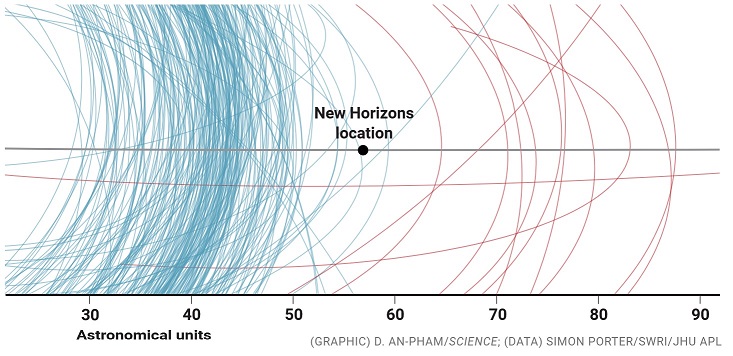 The finding ...could suggest that the Kuiper belt either extends much farther than once thought or ...that a "second" belt exists. When the New Horizons spacecraft went past the assumed limit of the Kuiper belt, the count from the dust detector did not fall off as expeeted. Meanwhile, a dozen larger objects lying beyond that distance have been discovered using the ground-based Subaru Telescope (red orbits in illustration). They're likely comets, too.
The finding ...could suggest that the Kuiper belt either extends much farther than once thought or ...that a "second" belt exists. When the New Horizons spacecraft went past the assumed limit of the Kuiper belt, the count from the dust detector did not fall off as expeeted. Meanwhile, a dozen larger objects lying beyond that distance have been discovered using the ground-based Subaru Telescope (red orbits in illustration). They're likely comets, too.
 "Puzzling objects found far beyond Neptune hint at second Kuiper belt," by Paul Voosen, Science, 03 Oct 2023. "Puzzling objects found far beyond Neptune hint at second Kuiper belt," by Paul Voosen, Science, 03 Oct 2023.
 Comets: The Delivery System has history and updates. Comets: The Delivery System has history and updates.
| 02 Oct 2023 |
What'sNEW about HGT


|
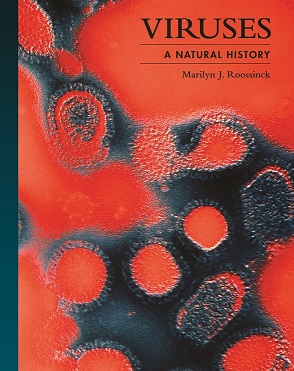 Viruses by Marilyn Roossinck is the best primer about them you are likely to find. The variety of viruses, in form and genetic system and capacity, is much more than most people realize. Roossinck pays attention to their effects on animals and plants; many individual species of viruses are featured in illustrated two-page chapters with territory world maps. Also discussed are vaccination, innate and acquired immunity, mosquitoes, control of host behavior, the Spanish flu, pioneering researchers like Rosalind Franklin and more. I especially like the colorful illustrations and charts on almost every page. Suitable for your coffee table!
Viruses by Marilyn Roossinck is the best primer about them you are likely to find. The variety of viruses, in form and genetic system and capacity, is much more than most people realize. Roossinck pays attention to their effects on animals and plants; many individual species of viruses are featured in illustrated two-page chapters with territory world maps. Also discussed are vaccination, innate and acquired immunity, mosquitoes, control of host behavior, the Spanish flu, pioneering researchers like Rosalind Franklin and more. I especially like the colorful illustrations and charts on almost every page. Suitable for your coffee table!
Roossinck knows that most viruses cause no harm, and that viruses are often endogenized. She even comments, "About 30% of the protein adaptations that make us human have been shaped by the viruses that infected our ancestors." She knows that viruses are everywhere, they are easily transferred, and the vast majority of them are completely unknown. But she makes no extrapolation from these facts, and her chapters on evolution are strictly conventional.
From my cosmic ancestry perspective, the implications are overwhelming. Given the ubiquity of viruses, we animals and plants must get new exposure every day. That gives macroevolution a ready and credible mechanism. I am susprised that mishaps like birth defects and disease aren't even more frequent. How do our systems safely cope with that genetic traffic? And what potential would lie in the vast store of unknown genes that viruses carry?
 Viruses: A Natural History by Marilyn J. Roossinck, Princeton University Press, 02 May 2023. Viruses: A Natural History by Marilyn J. Roossinck, Princeton University Press, 02 May 2023.
 Viruses... has my own learning curve. Roossinck has a much fuller story. Viruses... has my own learning curve. Roossinck has a much fuller story.
 07 Feb 2018: Every day, more than 800 million viruses are deposited per square metre.... 07 Feb 2018: Every day, more than 800 million viruses are deposited per square metre....
 Robust Software Management suggests that genomes would have systems to cope with genes from viruses. Robust Software Management suggests that genomes would have systems to cope with genes from viruses.
![]()
|

 Genes always look too old, by molecular clock dating, than they should be according to the fossil record. The fossil record is now extensive and considered accurate — red triangles in the graph indicate two reliable dates. But the clock data, tan and blue bars that should match the left and right triangles, respectively, are imprecise, and the whole range looks wrong. A recent analysis suggests that faulty statistical methods may lead to the dilemma.
Genes always look too old, by molecular clock dating, than they should be according to the fossil record. The fossil record is now extensive and considered accurate — red triangles in the graph indicate two reliable dates. But the clock data, tan and blue bars that should match the left and right triangles, respectively, are imprecise, and the whole range looks wrong. A recent analysis suggests that faulty statistical methods may lead to the dilemma.


 We discover hundreds of thousands of regulatory elements that emerged very recently in evolution and are specific to primates and humans, and are not present in other mammals.
We discover hundreds of thousands of regulatory elements that emerged very recently in evolution and are specific to primates and humans, and are not present in other mammals.

 When and where did COVID-19 first infect people? A comprehensive review of this issue, looking at archived samples from around the world, indicates that human infections became widespread earlier and more rapidly than previously known. For example, in mid-November 2019, SARS-CoV-2 RNA suddenly spiked and remained high in the sewage of Florianópolis, Brazil (graph). Blood and tissue samples from France, Italy and the US Northwest tell a similar story. So the evidence is clear that the virus was circulating both in China and internationally by November 2019 at the latest. We can also say with strong confidence that it was not circulating prior to July 2019, and it may not have been around before October 2019....
When and where did COVID-19 first infect people? A comprehensive review of this issue, looking at archived samples from around the world, indicates that human infections became widespread earlier and more rapidly than previously known. For example, in mid-November 2019, SARS-CoV-2 RNA suddenly spiked and remained high in the sewage of Florianópolis, Brazil (graph). Blood and tissue samples from France, Italy and the US Northwest tell a similar story. So the evidence is clear that the virus was circulating both in China and internationally by November 2019 at the latest. We can also say with strong confidence that it was not circulating prior to July 2019, and it may not have been around before October 2019....

 The finding ...could suggest that the Kuiper belt either extends much farther than once thought or ...that a "second" belt exists. When the New Horizons spacecraft went past the assumed limit of the Kuiper belt, the count from the dust detector did not fall off as expeeted. Meanwhile, a dozen larger objects lying beyond that distance have been discovered using the ground-based Subaru Telescope (red orbits in illustration). They're likely comets, too.
The finding ...could suggest that the Kuiper belt either extends much farther than once thought or ...that a "second" belt exists. When the New Horizons spacecraft went past the assumed limit of the Kuiper belt, the count from the dust detector did not fall off as expeeted. Meanwhile, a dozen larger objects lying beyond that distance have been discovered using the ground-based Subaru Telescope (red orbits in illustration). They're likely comets, too.
 Viruses by Marilyn Roossinck is the best primer about them you are likely to find. The variety of viruses, in form and genetic system and capacity, is much more than most people realize. Roossinck pays attention to their effects on animals and plants; many individual species of viruses are featured in illustrated two-page chapters with territory world maps. Also discussed are vaccination, innate and acquired immunity, mosquitoes, control of host behavior, the Spanish flu, pioneering researchers like Rosalind Franklin and more. I especially like the colorful illustrations and charts on almost every page. Suitable for your coffee table!
Viruses by Marilyn Roossinck is the best primer about them you are likely to find. The variety of viruses, in form and genetic system and capacity, is much more than most people realize. Roossinck pays attention to their effects on animals and plants; many individual species of viruses are featured in illustrated two-page chapters with territory world maps. Also discussed are vaccination, innate and acquired immunity, mosquitoes, control of host behavior, the Spanish flu, pioneering researchers like Rosalind Franklin and more. I especially like the colorful illustrations and charts on almost every page. Suitable for your coffee table!